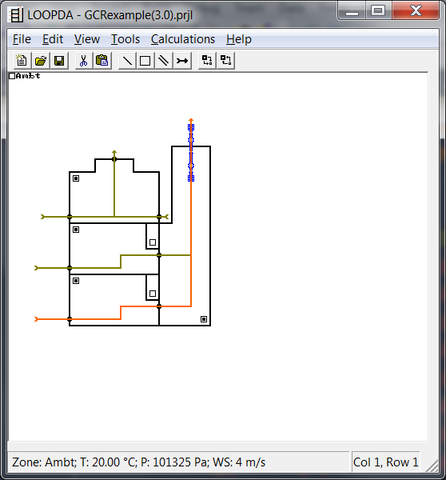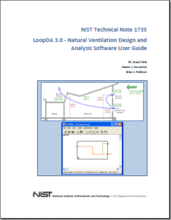LoopDA
LoopDA is a natural ventilation design tool developed by the National Institute of Standards and Technology. Version 3.0 is an update to the original version 1.0 that was developed in 2003.

This software tool can be utilized to determine the size of natural ventilation openings necessary to provide airflow rates that satisfy design objectives based on minimum ventilation and cooling load requirements, for example as determined using the Climate Suitability Tool. The method employed is based largely upon the Loop Equation Design Method that provides for sizing of openings to utilize driving wind and stack pressures to achieve design airflow rates. This version implements a simple thermal design calculation to assist in determining design temperatures and airflow rates. A streamlined interface more efficiently implements the design process ( as compared to version 1.0). The documentation provides a design example that demonstrates how to use the software.
Download LoopDA 3.0
The following procedure enables you to save the installer "LoopDA.msi" to your computer.
- Click on "[ LoopDA-setup.msi ]" below.
- Select "save this program to disk" and click "OK".
- Choose or create a folder into which you want to save LoopDA-setup.msi and click "Save". This will save LoopDA-setup.msi to your hard disk.
- Open the folder to which you saved LoopDA-setup.msi.
- Run the LoopDA-setup.msi and follow the prompts to install LoopDA.
Download LoopDA 3.0: [ LoopDA-setup.msi ] (approximately 1.67 MB)
Modifications to LoopDA
LoopDA 3.0 is an update to LoopDA 1.0. It is referred to as 3.0, because it utilizes the simulation engine of CONTAM 3.0 to perform the analysis. The following is a list of new features of version 3.0. Some of these features were influenced by the feedback provided by a design engineer who evaluated the usability of version 1.0 [Daly 2003].
Added a Simple Thermal Design Calculation
In version 1.0, the user was required to select a design airflow rate and temperature difference based on their judgment or calculations performed external to the program. LoopDA 3.0 now provides a simple thermal design calculation that determines these values based on a new set of zone properties including: zone dimensions (floor area and external surface area), minimum airflow requirements, heat sources and overall heat transfer coefficient of the external surface area. A Simple Thermal Design dialog box provides a list of available loops and associated zones along with relevant airflow requirements (minimum ventilation rate and cooling load). Users set the design airflow rate for each loop based on this information then execute the simple thermal design calculation to:
- balance the airflow through the loops,
- set the design airflow rates for the natural ventilation airflow components (paths and ducts),
- perform a steady-state heat transfer calculation to determine the resultant temperature of ventilation air for each of the airflow components.
Modified Loop Drawing
In LoopDA 1.0 the user was required to draw the complete pressure loop that started and ended at the same point on the SketchPad. Now one need only draw an "arrow" that indicates the intended airflow paths through the building. Drawing begins outside of the building through the desired flow paths and ducts, and ends just outside the path (or duct) through which the air is to exit. This approach provides a more conceptual view of how a designer might represent their intended airflow patterns.
Integrated Asymptotic Plots
LoopDA 1.0 required the user to export loop data to a text file, import the text file to a spreadsheet template, and then utilize the spreadsheet to generate so-called asymptotic plots of the relationship between the sizes of the airflow paths and ducts associated with each loop. The need for this cumbersome process has been eliminated. The ability to generate and view these plots has been directly integrated into the program, greatly streamlining the design process.
Streamlined LoopDA Interface
LoopDA 1.0 was largely based on the ContamW code base. This resulted in an interface that contained some unnecessary and somewhat cumbersome features. The following is a list of how the interface has been streamlined:
- The menus have been reduced to include only LoopDA-related commands.
- The icon placement menu only allows the drawing of LoopDA-related icons: zones, paths and annotations.
- Wind pressure is now simply accounted for via a wind pressure coefficient provided for each individual envelope path or duct terminal.
- Only those flow element types available in LoopDA are listed for selection (orifice, general powerlaw, self-regulating vent). The creation of each flow path or duct now automatically generates a distinct airflow or ductflow element.
- Zone properties have been enhanced to support the simple thermal design calculation.
Simplified Analysis Calculation
The calculations consist only of steady airflow calculations by ContamX, so access to the simulation run control has been omitted. If one wishes to perform a more detailed calculation, the LoopDA project can be saved as a CONTAM project to utilize the full capability of CONTAM. A comparison between the design and analysis values is provided directly on the SketchPad.
Added a Self-regulating Vent
A self-regulating vent airflow component was added based on the work of James Axley [Axley 2001a].
LoopDA User Guide

There is a LoopDA compiled HTML help file (LoopDA.chm) that is installed with the program. It can be accessed via the help menu in the program. It is also provided here for your convenience as a PDF. LoopDA User Guide [PDF: 1.01MB] - Last updated 03/07/2012.
Contacts
-
(301) 975-6459
-
(301) 975-5860
-
(301) 975-6445

